Sajama National Park, Travel Guide
Posted by Ariane on Jan 14, 2013 in Bolivia, Countries | 4 comments
How to go to Sajama, where to stay, what you will see and what you need to know. This post is designed to help people who are interested in visiting this fabulous place plan their trip and avoid a few common mistakes.
* 1$=6.95 BoB (2012)
After 10 days in Oruro, the national park of Sajama was our next destination. We decided to go there between Christmas and the New Year to avoid any unfortunate surprises, as the only phone number we had for booking an accommodation didn’t work. Here is what we did, step-by-step.
How to go to Sajama National Park from La Paz or Oruro
You can get to Sajama either from La Paz or Oruro, or any other place from where you can catch a bus to Patacamaya. The only buses that go to Sajama directly are the ones to Arica in Chile, but they will drop you 12 km from Sajama village, so you will have to wait for a car to pass by, or walk!
From Oruro you have three options:
- Take a minibus to Patacamaya (we didn’t find the stop, but it’s near the bus station)
- Take a bus for La Paz and get of at Patacamaya (that’s what we did). Note that you will have to pay the full price to La Paz for the ticket (25 BoB/each)
- Third option is to take the bus that goes to Chile and get of 12 km from the village of Sajama.
From Patacamaya:
Once you’re in Patacamaya you will have to wait for the ONLY bus that goes to Sajama to be full. The bus will leave between 12 pm and 1.30 pm, so you need to be there BEFORE 12 pm.
The ride to Sajama lasts three hours. It is shorter on the way back, and it costs 25 BoB each. There are no stops or breaks during this three-hour ride (use the toilet beforehand). Also, the seats are not that wide or big, and there is no room for stretching.
*Though Patacamaya is a small village, you will find toilets, restaurants and fruit available. It is also the place where people in Sajama get supplies, as nothing grows in Sajama.
Note that sometimes there is no bus to Sajama on Sundays, so play it safe and be flexible.
In Sajama National Park:
Once you’re in Sajama (which is quicker and easier than it sounds), you will have to pay for entrance to the park, 30 BoB/person. You will also need to register at the park with your passport information.
How to leave Sajama National Park
To go back to Patacamaya, the same bus leaves Sajama every day (again, double check for Sundays) at 5.30 am. You need to be at the square (aka plaza) at 5.15 am, and wear a lot of warm clothes as it is totally freezing at that time, even in summer!
Where to stay in Sajama
We asked at different places in Oruro about the various options for accommodation in Sajama.
Here are the answers we got:
- At Oruro’s tourist information office they told us there was an “Albergue” for 50 each full board. At the beginning we understood 50BoB, so we thought, “Wow, really cheap!” But after further research on the Internet, it turned out that it was $50 USD each, so $100USD total, which is very different! In addition, the Albergue is 10 km from the village, and we found a blog where people were saying that they didn’t have hot water (which is ok for 100BoB, but not for $100 USD!)
- Then we asked at the hotel where we were staying (Hotel Houston), and the nephew’s owner (who had already been in Sajama) told us that we could stay with families for 35BoB each. This option was mentioned in our guidebook, but again, you’re not sure to have hot showers.
- There are also hostels (the option we chose). When we arrived, the park ranger offered to take us to the hostels and families, and then we could choose where we’d stay. We were there in the low season (January), so it seemed that the only hostel open was the “Hostal Sajama,” where we stayed for 100BoB (50 each) , with private bathroom and hot water (some rooms didn’t have hot water, but they had heaters).
Where to eat
Sajama is a very small village. Only 80 families live there, so you don’t have many options. We took all of our meals at the Hostal Sajama for 18BoB/meal and 14BoB for breakfast (like the six other guests, with whom we spent the New Year’s holiday, like a family!). There is another “restaurant” at the grocery on the plaza, where the price was 14BoB/meal , but we didn’t try it.
What to pack
It is very important that you take:
- Sleeping bags. Some rooms had heaters, but not ours (you can’t have everything, right?!). It was really cold at night, as temperatures go below 0° Celsius.
- Warm and light clothes. During the day it can be quite hot.
- Sunglasses.
- Hat.
- Sun screen (very important because you don’t feel the heat when it is windy, so you can get a sunburn quite easily)
- Swimming suit for the hot springs.
- And the most important (which we didn’t have CHAPSTICK. In just two days our lips were devastated by the dry air because we didn’t have enough chapstick/lip balm. So this is not an option, it is a necessity!
Sajama for climbers
Thanks to Bryn Merrell and David Maletta, whom we met in Sajama and provided this information.
“The volcanoes there are a pair: to the left is Parinacota, and to the left Pomerape, which are both over 6,000 meters (this is what appeals to climbers). Then there is the massive one, Sajama, which is the highest point in all Bolivia and a very intense climb, due to both the glaciers and the altitude. All three of these peaks are in the Cordillera Occidental mountain range, which has an impressive number of mountains to climb.
All three volcanoes are best climbed in Bolivia’s climbing season , which is best between May and August. We were there just at the beginning of rainy season, which had much more snow and a higher chance of lightning storms.
A lot of climbers suggest doing Parinacota and Pomerape both in five days , with a day of rest at base camp in between. Pomerape is rated at a more difficult level then Parinacota due to the technical ice climbing needed to cross a large hanging glacier near the summit. However, Parinacota is higher in altitude.
For climbing, we referenced the guidebook The Andes, A Guide For Climbers by John Biggar, which includes the entire Andes mountain range. For equipment, we brought: ice axes, crampons, single layer climbing boots, pickets for protection in snowy conditions, rope, ice screws, a stove to melt snow and burn unleaded fuel, and wind protection. However, we did not end up using the rope, picket, or ice screws for Parinacota (because it was not necessary). It would probably be useful to double layer boots in climbing season because the weather is not as warm. And of course, bring a shotgun if you are interested in fresh Vicuna for dinner!”

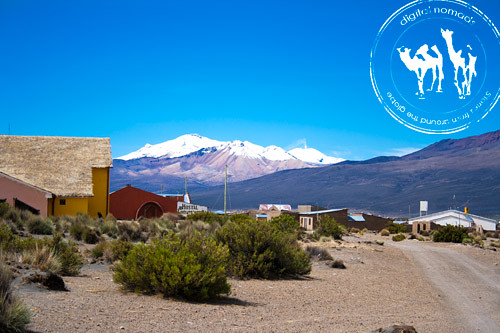
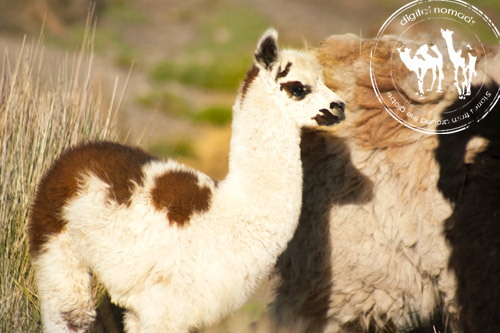
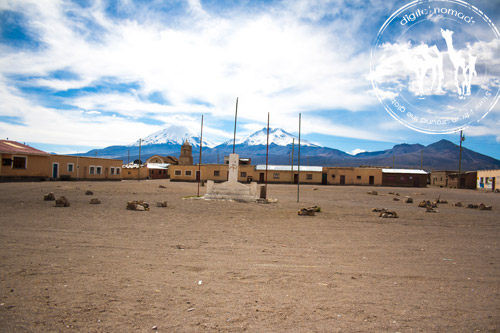
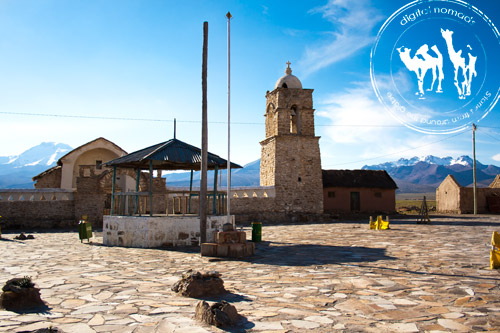

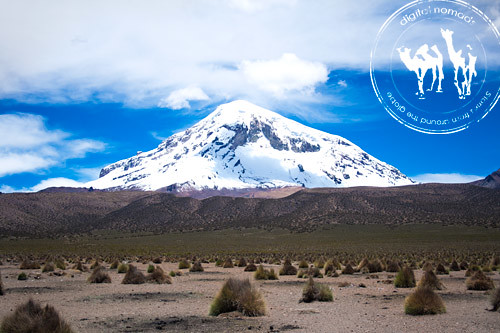
 Bassel & Ariane, a couple who quit their jobs to realize their dream "traveling around the world". This travel website is our way to share with you the amazing adventures we have had, with the goal of helping to make your own travels more enjoyable.
Bassel & Ariane, a couple who quit their jobs to realize their dream "traveling around the world". This travel website is our way to share with you the amazing adventures we have had, with the goal of helping to make your own travels more enjoyable.
Great post! I’m planning to visit Sajama National Park in August and I would know how did you visit the park? By foot or it’s possible to hire a car/motorbike there? Or there are organized tours starting from Sajama? Thank you very much!
Thanks! Most of our time in Sajama was on foot but one day we hired a ride–with other travelers–and went to see the laguna. We met Belgium guys/gals who went to a lake within Chili borders and they saw ’emeu’, they hired a car as well. So for the hiring part, it was all through the hotel owner but you can ask the villagers as well.
No organized tours from Sajama as far as we know. Don’t forget to take warm clothes!
Enjoy and safe travels, it’s so great and very peaceful over there.
Hello, I will be going to Sajama National Park this summer to climb Sajama, Parinacota and Pomerape. Are there any grocery stores in Sajama? specifically for food I can take onto the mountain with me.Also did you happen to see any fuel there for climbers? Snacks, rice, beans bread. Or do you suggest getting all that food in La Paz before going into the village.
Great post, very informative. Thank you.
Hey James, there were a couple of grocery stores when we were there but with limited supplies and varieties. La Paz would be a good place to do your shopping or you can also buy some food from Patacamaya. Safe travel!